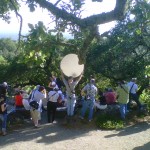Last updated on July 28th, 2022 at 03:12 pm
 Recently, I offered to be a 2nd photography shooter to help a local freelance photographer friend photograph a wedding he was hired to shoot.
Recently, I offered to be a 2nd photography shooter to help a local freelance photographer friend photograph a wedding he was hired to shoot.
The wedding was small, but it had both indoor and outdoor locations so it was an opportunity to practice both natural light and flash photography.
Based on the experience, I made a list of 8 helpful tricks for anyone who wants to be a successful 2nd shooter at an event:
1. Make sure your equipment is organized and prepared for a day of shooting
-
- Clean and pack all of your lenses.
- Charge all of your batteries for the camera and your external flash.
- Have plenty of photo cards and make sure they are cleaned and formatted.
- Remember items like extension cords, lens cleaners, duct tape, reflectors, and your tripod.
- Pack a small ‘accessories bag’ with a few Band-Aids, Motrin, tiny scissors, a few safety pins, and a Tide To Go Stain-Out Pen.
There may be other items you can bring based on where you are going, so give it some thought. Think about what could go wrong at your venue, and prepare as best as possible. It’s better to have it and not need it than to need it and not have it. Right?
2. Pack a bag of snacks
Staying hydrated and eating a little bit every few hours is essential. I brought along water, an orange, a bag of nuts, and some dry frosted mini wheat cereal. The bride and groom arranged for our crew to eat dinner that night, but I would never make that assumption. Bring what you need just in case because you can’t leave the reception and come back.
And don’t forget to pack some breath mints.
3. Arrive early
If you are late, the lead photographer may question your value or worry about your professionalism. The last thing you want to do is frustrate him or make him feel rushed. Find out what time the lead will get there, and then plan on arriving 10 minutes before him. Be there waiting with a smile and your excitement for the opportunity to help out.
4. Review your game plan
Spend a few minutes with the team confirming the flow of the day. If you have questions about equipment, get the answers. Confirm your shooting role at the wedding ceremony and reception. Little things like weather changes from sun to rain could have a major impact on your shooting strategy.
I found a great wedding photography checklist at ForBetterForWorse. It’s very detailed and can be a great starting place for the team to get clear on what shots are important to capture.
Yes, write it down. Trying to keep all the details in your head will not work.
5. Be present and invisible at the same time

You are in an assistant role. You should be aware and available for the photographer and the family, without taking over. Make suggestions for interesting backgrounds or for shots they may have been overlooked.
Help the team with large group shots and keep the other guests at bay.
Ask the lead photographer if it’s ok before handing out your own business card especially if you are a photographer that also books weddings.
6. Take shots that are non-traditional
The lead photographer will most likely be in charge of getting the more traditional shots—so why not approach your role as a “documentary filmmaker.” Take guest action shots, behind-the-scenes stuff, non-traditional points of view, and use other lenses for different effects.
Pay attention to any kids, especially as they tend to become the life of the party when the music starts.
7. Finish strong
By the end of the day, you’ll probably be exhausted, like everyone else. Make certain to do a few simple things to finish strong:
-
- Thank the lead photographer and the staff for the shooting experience.
- If appropriate, thank the venue location staff and family members you have met throughout the day.
- Re-pack your bag with the same care and organization as you did before the event.
- Before you leave the location, ask the lead photographer if there is anything else you can do to help the event end on a successful note.
8. Remember to follow-up
A few days after the wedding, get in touch with the lead photographer. Send a handwritten note or make a quick call, thanking them for the opportunity to work together. Let them know directly if you would be interested in helping out again in the future.
If you want feedback about the support you gave, ask questions like “What did you like about the way I helped out,” and “If we work together again, what would you change so the day will be more successful?”
Moving forward on my big dream journey
On my path to becoming a successful freelance photographer, I’ll look for more photography events and opportunities to participate with my camera to gain photography confidence and narrow my business niche. I did enjoy being the second shooter at this wedding, and I would certainly do it again if the opportunity arose.
However, I am certain that my freelance photography dream will not include being a wedding photographer. Nothing against brides and grooms, but now that I have experienced shooting a wedding, I can check it off my dream goal list and look into other kinds of photography events to try.
Always be refining your craft.
Remy Gervais
Remy Gervais is a successful business coach and a freelance photographer residing in the northern California wine country.

Enjoy this special 8WomenDream Guest Contributor story submitted by new and experienced big dreamers throughout the world, edited and published to capture a dream perspective from different points of view. Do you have a personal dream story to share with 8WomenDream readers? Click here to learn how to submit dream big articles for consideration.
Note: Articles by Guest Post Contributors may contain affiliate links and may be compensated if you make a purchase after clicking on an affiliate link.




